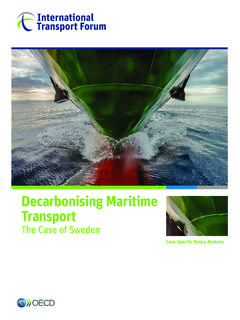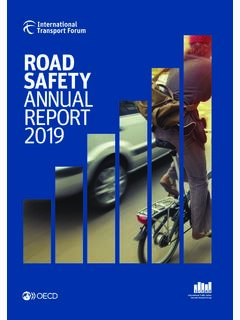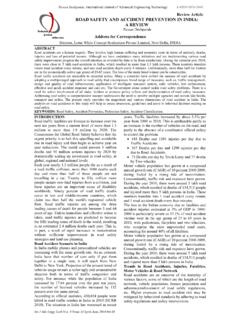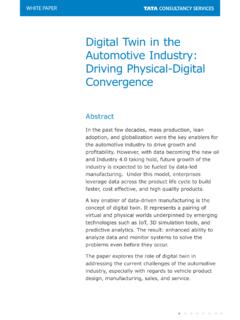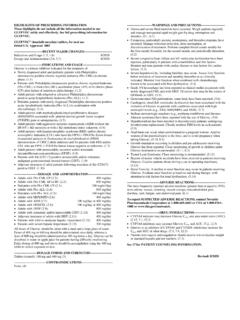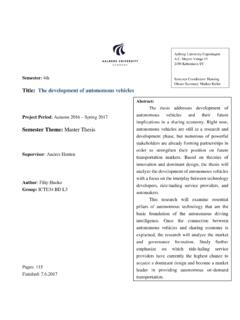Transcription of ROAD SAFETY REPORT 2020 | JAPAN - Home | ITF
1 road SAFETY REPORT 2020 | JAPAN 1 JAPAN JAPAN recorded 3 920 road fatalities in 2019, representing a 6% decrease when compared to 2018. In 2019, JAPAN reached the lowest level of road mortality since systematic records began in 1948. A priority area is the provision of a safer road transport system for senior citizens a group that suffers more than half of all road deaths in JAPAN . The 10th Traffic SAFETY Programme was launched in March 2016 and covered the period 2016-20. Improving the SAFETY of pedestrians and cyclists, including seniors, is an important focus of the programme. An evaluation of the current programme is underway. Impact of Covid-19 In response to the Covid-19 pandemic, JAPAN introduced lockdown measures on 9 March 2020, which affected the movement of people and goods on the road and in turn the exposure to road crashes.
2 A gradual lifting of lockdown measures started on 18 May 2020. The number of road deaths decreased by 22% during the period March-September 2020, compared to the average for 2017-19, according to preliminary data for 2020. The largest drops were recorded in July (-31%) and August (-32%). Table 1. road fatalities by month Average 2017-2019 2020 % change January 342 318 -7 February 296 298 March 331 283 April 312 246 May 304 237 -22 June 283 236 July 327 225 August 354 239 September 351 296 Trends JAPAN registered an overall decrease in the number of road deaths in 2019. According to the latest available data, 3 920 persons lost their lives in traffic crashes in JAPAN in 2019. This represents a 6% decline on 2018,when 4 166 road deaths were reported, itself a 6% decline on 2017. The long-term trend for road deaths in JAPAN shows significant progress.
3 Between 2000 and 2019, the number of annual road fatalities fell by 62%. road SAFETY REPORT 2020 | JAPAN 2 The number of traffic deaths per 100 000 inhabitants in JAPAN fell by 62% between 2000 and 2019. In 2019, traffic deaths per 100 000 inhabitants were recorded, compared to in 2000. By way of comparison, the average in the European Union was deaths per 100 000 inhabitants in 2019. Measured as traffic deaths per billion vehicle-kilometres (vkm) driven, the fatality risk in JAPAN shows similar longer-term progress. In 2018, this metric stood at , 59% lower than in 2000. JAPAN recorded road fatalities per 10 000 registered vehicles in 2019. This represents a decrease of 64% compared to the year 2000, when the rate of deaths to registered vehicles stood at Figure 1. road SAFETY , vehicle stock, traffic and GDP trends Index 2000 = 100 Data for fatalities by road user group show that pedestrians constitute the group most affected by road crashes.
4 In 2019, pedestrians accounted for the largest share of road deaths, with 36% of the total. They were followed by passenger car occupants (23%), cyclists (16%), motorcyclists (10%) and moped riders (5%). In 2019, 1 434 pedestrians were killed on Japanese roads. About 70% of all fatal pedestrian accidents in JAPAN occur while people are crossing the road , and a third of these crashes occur on a pedestrian crossing. Country Profile Population in 2019: million GDP per capita in 2019: USD 40 278 Cost of road crashes: of GDP (2009) road network: million kilometres (2019) Registered motor vehicles in 2019: million (cars 68%; goods vehicles 16%; motorised two-wheelers 12%) Volume of traffic: between 2000 and 2018 Speed limits: 40/50/60 km/h on urban roads; 50/60 km/h on rural roads; 100 km/h on motorways Limits on Blood Alcohol Content (BAC): g/l road SAFETY REPORT 2020 | JAPAN 3 The largest decrease in fatalities in 2019 was registered among moped riders, who suffered 64 fewer fatalities ( ) than in 2018.
5 Likewise, motorcyclists had 46 fewer deaths ( ) compared to 2018. Pedestrians had less fatalities, cyclists less and passenger car occupants less year-on-year in 2019. The long-term trend shows that traffic in JAPAN has become safer for all road user groups. Since 2000, road fatalities for each road user group have gone down 50% or more. Moped riders registered the strongest decline, with 79% fewer road deaths in 2019 than in 2000. Passenger car occupants strongly benefitted from road SAFETY improvements, as well, with a reduction of 69% over this period. Figure 2. road fatalities by road user group, 2019 road deaths by age group in 2019 showed some changes compared to 2018. road deaths decreased among 15-17-year-olds and for 0-14-year-olds. People aged 65-74 experienced fewer road fatalities in the same period and those 25-64 had less.
6 On the other hand, those aged 18-20 had more road fatalities, and 21-24-year-olds had more. In 2019, 2 258 elderly people died in road traffic crashes. Despite a downward trend in all traffic fatalities, the trend for people over 65 tends to be flatter than other age groups, as the population share of elderly people is increasing. However, the number of elderly deaths per 100 000 people continues to decline at the same rate as fatalities for all ages. Seniors over 65 are the group at highest risk in Japanese road traffic; the risk is even greater for those over 75: in 2019, they had a mortality rate of per 100 000 persons, when the national average was per 100 000. The alarming rates of traffic fatalities among the elderly prompt concern for the future. In 2018, 28% of the Japanese population was over 65, the highest rate among all OECD countries, for which the average rate was 17% (OECD, 2019a).
7 As life expectancy road SAFETY REPORT 2020 | JAPAN 4 continues to rise and fertility rates remain low, the elderly share of the population is projected to grow in the coming decades (OECD, 2019b). Figure 3. road fatality rates by age group, 2010-19 Deaths per 100 000 inhabitants in a given age group Figure 4. road fatality rate by age and road user group, 2019 Fatalities per 100 000 inhabitants Analysis of fatalities by road type shows that the urban network is the deadliest in JAPAN . In 2019, 60% of deaths occurred on urban roads, 37% on rural roads and 3% on motorways. This repartition has remained relatively stable in recent years. In 2019, the number of road deaths decreased year-on-year on urban roads and on rural roads. On the other hand, the number of road deaths increased on motorways in 2019.
8 road SAFETY REPORT 2020 | JAPAN 5 Since 2000, fatalities have decreased 54% in urban areas, 71% on rural roads and 56% on motorways. Figure 5. road fatalities by road type Figure 6. Evolution of road deaths by user category, age group and road type, 2010-19 Economic costs of road crashes According to the latest research published by the cabinet office in JAPAN , economic loss due to traffic crashes in 2009 was estimated at JPY 3 979 billion, corresponding to of GDP. This estimate includes medical costs, lost profit, funeral costs, compensation expenses, property costs and other costs. road SAFETY REPORT 2020 | JAPAN 6 Behaviour The behaviour of road users is an important determinant of a country s road SAFETY performance. Inappropriate speed, in particular, is one of the main causes of road crashes.
9 Violation of the speed limit was recorded in police records in of all road fatalities in 2019. The table below summarises the main speed limits in JAPAN . Table 2. Passenger car speed limits by road type, 2020 General speed limit Urban roads 40, 50, 60 km/h Rural roads 50, 60 km/h Motorways 100 km/h Driving under the influence of alcohol is another cause of road crashes in JAPAN . In 2019, it was reported that 193 people were killed in alcohol-related crashes ( of all road deaths) and that of all crashes were due to a driver being under the influence of alcohol. The share of alcohol-related crashes decreased due to more severe sanctions and more frequent controls. However, in recent years stagnation has been observed in the number of alcohol-related crashes. In 2002, the maximum authorised blood alcohol content (BAC) level was lowered from g/l to g/l.
10 An increasing problem for traffic SAFETY is distraction, especially through the use of mobile phones on the part of both drivers and pedestrians. In 2019, distraction due to the use of mobile phones was identified as the primary cause in about of all road traffic crashes. It is forbidden in JAPAN to use a mobile phone while driving. The share of sleepiness and fatigue as a causal factor in crashes is especially challenging to detect. Based on national traffic crash statistics produced by the National Police Agency, of all injury crashes and of all road fatalities in 2019 were caused by drowsiness. The actual number could, however, be higher. Seat belt wearing has been compulsory in front seats since 1985 and in rear seats since 2008. Children under six years old must be seated in a dedicated child restraint system. While the seat belt wearing rate is high for front seat occupants, it is low in rear seats.
